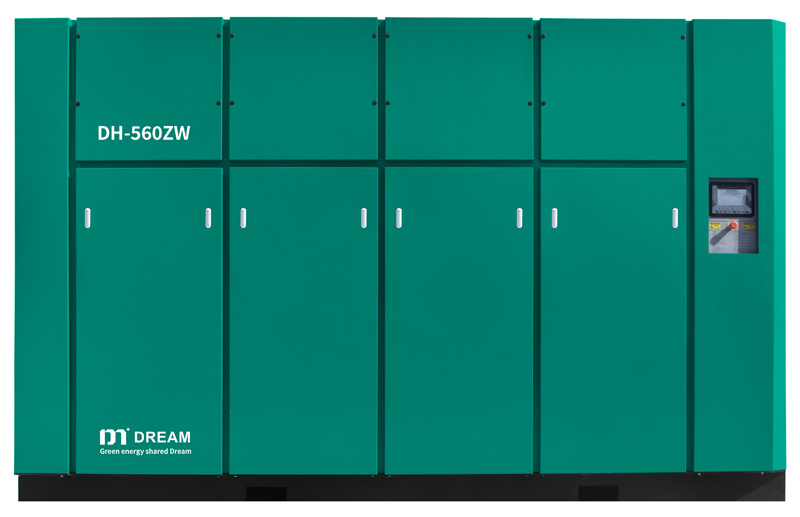Learn how to evaluate & choose a two-stage rotary screw compressor for maximum energy savings, lower specific power, and efficient compressed air performance.
In most industrial facilities, the compressed air system is one of the largest energy consumers. Studies show that electricity costs can account for 70–80% of the total life cycle cost of an air compressor. Choosing an energy efficient air compressor not only reduces operating expenses but also minimizes environmental impact.
Among the many technologies available, two-stage rotary screw compressors have gained attention for their energy savings and long-term reliability compared to single stage machines. This guide will help you evaluate performance, understand the advantages of two-stage designs, and choose the right model for your application.
How to Measure Energy Efficiency in Screw Compressors
To evaluate whether a compressor is truly efficient, focus on these metrics and methods:
1. Specific Power of Air Compressors
This is the amount of electrical power required to produce a certain amount of compressed air, typically expressed as kW/100 cfm or kW per m³/min.
- Lower specific power = higher efficiency.
- Compare your compressor’s values against industry benchmarks.
2. Capacity Control and Control Systems
A high-quality control system ensures the compressor only produces the required airflow, avoiding waste. For fixed speed compressors, efficiency drops when running under partial load, while variable-speed (VSD) models can adjust motor speed to match demand.
3. Pressure Optimization
Reducing discharge pressure saves energy: every 2 psi decrease can reduce power consumption by about 1%.
4. Monitoring Tools
Installing power meters and flow sensors allows you to track consumption and efficiency over time, helping you spot performance losses early.
Why Two-Stage Rotary Screw Compressors Save More Energy
Compared to single stage screw compressors, two-stage models offer key advantages:
- Lower Compression Ratio per Stage – The total pressure increase is split between two compression stages, reducing internal leakage and heat generation.
- Interstage Cooling – After the first stage, air is cooled before entering the second stage, reducing the work needed and improving volumetric efficiency.
- Proven Energy Savings – Example: Single Stage: 250 hp, input power 212.6 kW, annual electricity cost ≈ $193,466 Two-Stage: 200 hp, input power 188 kW, annual electricity cost ≈ $171,080 Annual Savings: ~$22,386 (≈ 11.6%) Even with a higher initial cost (~$13,000 more), the payback period is only about 7 months, with years of net savings afterward.
The DREAM DHV-Z Series Permanent Magnet Double Frequency Two-Stage Compression Screw Air Compressor is designed for maximum energy savings:
- Energy Efficient Design – IE5 permanent magnet synchronous motor for top-tier performance.
- Advanced Cooling – Independent interstage cooling, enlarged cooler ceiling row, and optimized hot/cold zone separation.
- Low Noise Operation – Silent centrifugal fan for quiet working environments.
- Dual Frequency Conversion – Both the host and fan use frequency conversion to match demand.
- Durability & Protection – High-temperature shutdown Motor overload protection IP54 protection grade Electrical components placed in the cool zone to extend lifespan.
- Efficient Oil Separation – Cyclone internal and external oil separator design reduces oil content and pressure loss, lowering maintenance costs.

Practical Steps to Evaluate Your Current or Future Compressor
- Measure Specific Power – Install power and flow meters to calculate kW/100 cfm or kW/m³/min.
- Check Capacity Control Type – See if your unit has a VSD or relies on fixed speed control.
- Compare to Two-Stage Benchmarks – If your current rotary screw air compressor has higher specific power, upgrading could yield large savings.
- Analyze Operating Pressure – Adjusting setpoints can produce measurable energy savings.
- Schedule an Energy Audit – Professional audits identify leaks, pressure drops, and system inefficiencies.
Conclusion & Call to Action
Two-stage rotary screw compressors deliver significant energy savings, lower operating costs, and improved reliability over their lifetime. With rising energy prices, upgrading to an energy efficient air compressor can quickly pay for itself.
Contact DREAM Compressor today to analyze your compressed air system’s performance, request a free energy audit, and discover how a two-stage rotary screw compressor can reduce your plant’s energy consumption and costs.
